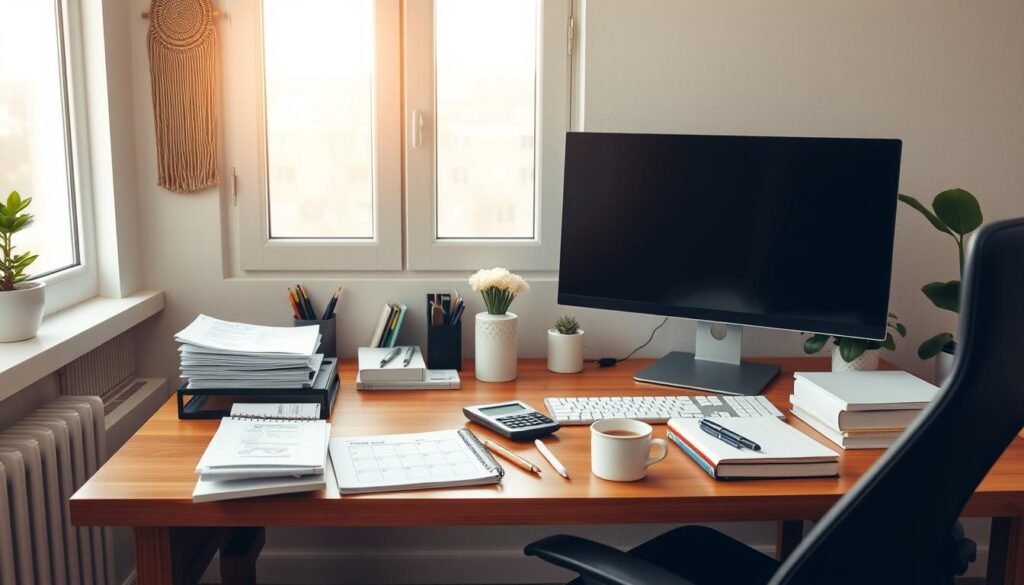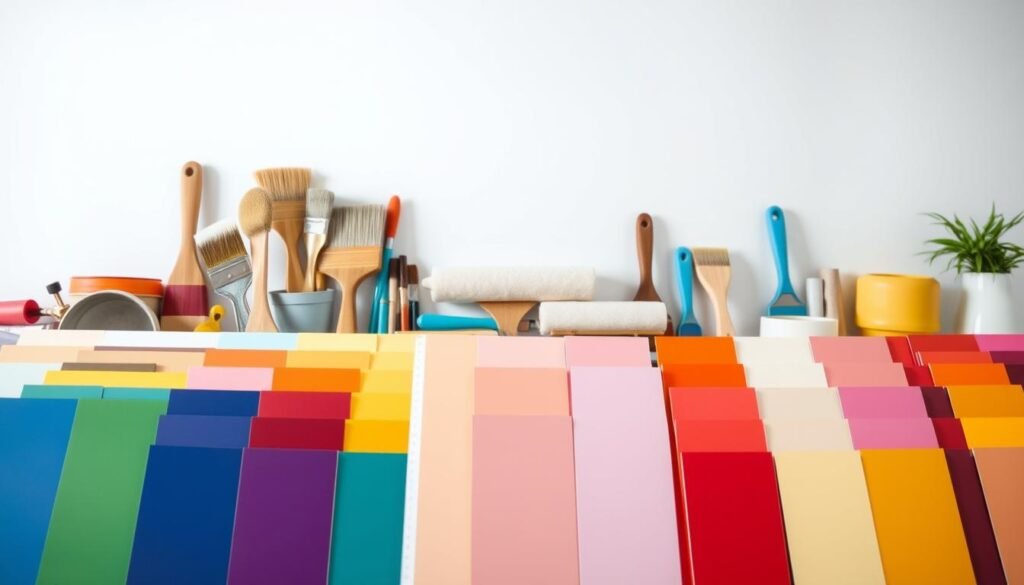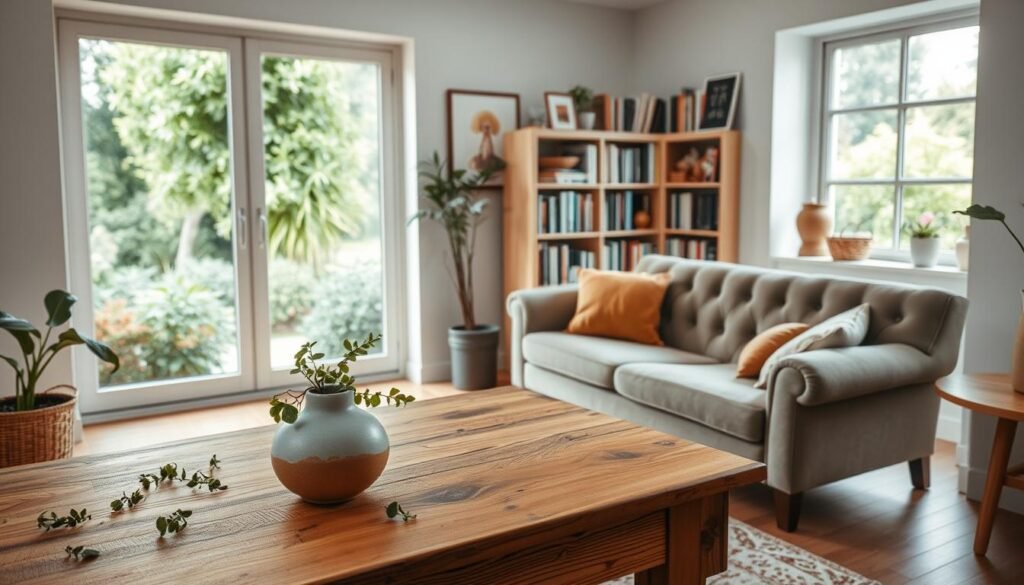Transforming living areas into stylish, functional zones doesn’t require magic – just smart planning. Many feel intimidated by design projects, worrying about costs or lack of expertise. What if limitations became your greatest creative allies?
This guide reveals how methodical thinking turns overwhelming tasks into achievable milestones. You’ll learn to repurpose existing items, mix textures effectively, and use color psychology – all while staying budget-conscious. Constraints aren’t roadblocks; they’re invitations to innovate.
We’ll walk through room-specific strategies that adapt to various lifestyles. Whether refreshing a studio apartment or reimagining a family room, our system prioritizes practicality without sacrificing character. The result? A space that feels authentically yours, not a catalog replica.
Key Takeaways
- Break projects into clear phases for stress-free execution
- Budget limitations often spark unexpected creative solutions
- Professional training isn’t required for stunning results
- Discover your unique aesthetic through guided experimentation
- Balance visual appeal with everyday functionality
Conceptualizing Your Design Vision
Great spaces begin with clarity before color swatches or fabric samples enter the picture. Start by mentally stripping the room bare – this blank canvas exercise reveals hidden potential and problem areas. What feels off-balance? Which elements spark joy? Jot down both pain points and prized possessions.
Discovering Your Interior Style
With over 25 established design styles ranging from industrial to coastal, exploration becomes key. Notice patterns in spaces that catch your eye – maybe mid-century lines or bohemian textures. Your true aesthetic often hides in plain sight, reflected in clothing choices or travel photos.
Function shapes form more than you might think. A home office demands different mood elements than a nursery. List daily activities for each zone – this practical approach naturally guides layout decisions and material choices.
Setting Clear Design Goals
Transform vague “I want it cozy” notions into actionable targets. Try: “Create reading nook with task lighting by October”. This method turns overwhelming projects into manageable steps while allowing creative flexibility.
Remember – styles evolve like fingerprints. That industrial loft inspiration might blend with farmhouse touches over time. Keep a digital scrapbook to track changing preferences, ensuring your space grows with you organically.
Creating a Mood Board for Your Project
Visual roadmaps transform scattered ideas into cohesive stories. Mood boards act as creative filters, helping identify patterns in what truly resonates with your vision. This process saves time and money by testing concepts digitally before physical changes occur.
Collecting Inspiration and Imagery
Begin by gathering images that spark joy – even if they seem unrelated. A sunset photo might inform your color scheme, while a textured throw pillow could inspire fabric choices. Authenticity matters more than trends during this exploratory phase.
Using Pinterest and Digital Tools
Platforms like Pinterest simplify design experimentation. Create secret boards to avoid outside opinions skewing your instincts. Search terms like “neutral living rooms” or “maximalist bedrooms” yield targeted results. Filter pins showing furniture against white backgrounds for clearer style analysis.
Combine existing room photos with potential new additions using free collage apps. This reveals clashes between wood tones or competing patterns early. Update boards weekly as your taste evolves – what excited you last month might feel outdated now.
| Tool | Best For | Key Feature |
|---|---|---|
| Initial inspiration gathering | Algorithm suggests similar styles | |
| Canva | Digital collage creation | Drag-and-drop templates |
| Milanote | Project organization | Combines notes with visuals |
| Adobe Express | Professional layouts | Advanced editing tools |
Successful mood boards balance mood and practicality. Include measurements of your space when pinning furniture. Note how natural light affects color samples in different room orientations. This strategic approach turns daydreams into achievable plans.
How to Make Your Own Interior Decoration: A Step-by-Step Process
Mastering home transformation requires structure, not guesswork. This design process simplifies complex decisions through nine strategic phases. Think of it as building blocks – each step prepares the ground for the next creative leap.
Defining Your Project Scope
Start by mapping which areas need attention. A kitchen refresh differs from a full living room overhaul. Set clear boundaries: “Complete primary bedroom by December” works better than vague aspirations.
Identify a springboard object – perhaps a vintage rug or art print. This anchor piece guides color schemes and style direction, ensuring harmony across elements. Budget-conscious? Focus on three high-impact zones first.
Organizing Ideas into a Cohesive Plan
Group inspiration sources into functional categories: seating, lighting, storage. Notice patterns – do you lean toward curved shapes or angular lines? This analysis reveals your innate preferences.
Prioritize foundational project components like flooring or key furniture. Save accent pieces for later stages. A numbered checklist prevents overwhelm: 1. Paint walls 2. Install lighting 3. Position sofa.
This process isn’t rigid – it’s a roadmap that adapts as you go. By methodically connecting each step, you’ll craft spaces that feel intentional rather than accidental.
Budgeting and Planning for Your Design Project
Smart financial planning turns design dreams into reality. Before selecting paint colors or furniture, establish clear spending limits. This approach prevents overspending while allowing creativity within set boundaries.

Prioritizing Expenses and Setting a Cash Flow
Start by categorizing needs using a three-tier system. Essentials like seating or lighting form the foundation. Desirable upgrades come next, followed by items that can wait. This method ensures critical elements get funded first.
| Priority Level | Description | Budget Allocation |
|---|---|---|
| Must Haves | Essential functional items | 60% of total funds |
| Nice to Haves | Style upgrades | 25% of total funds |
| Not Priority | Decorative extras | 15% of total funds |
Create a detailed spreadsheet tracking every expense. Include contractor bids, material costs, and delivery fees. Always obtain three quotes for professional services – prices often vary by 30% or more.
Building in a Contingency Fund
Unexpected costs derail even well-planned projects. Set aside 10% of your budget for smaller updates and 20% for major renovations. Track expenses weekly using budgeting apps to avoid surprises.
Focus funds where they create maximum impact. Invest in quality foundational pieces while saving on trendy accents. Remember – patience often leads to better deals. Wait for seasonal sales on lighting fixtures or textiles to stretch your money further.
Selecting Foundation Furniture and Key Elements
Building a room’s character starts with smart furniture choices that balance form and function. Neutral-toned sofas and adaptable tables act as chameleons – they anchor your space while allowing decorative experiments. Versatile pieces become the workhorses of your design, supporting evolving styles without constant replacements.
Choosing Versatile, Timeless Pieces
Aniline-dyed leather offers the perfect balance for active households. Unlike standard options, it resists scratches while developing a rich patina over time. Performance fabrics like Crypton repel spills without sacrificing softness – ideal for homes with kids or pets.
Slipcovers provide flexibility for light-colored furniture. Modern versions fit snugly, avoiding the frumpy look of older designs. When selecting key elements, prioritize clean lines over ornate details. These foundational choices create harmony across mixed aesthetics.
Creating a Functional Room Layout
Arrange seating to encourage conversation while maintaining clear pathways. Leave at least 3 feet between furniture pieces for comfortable movement. Test different configurations using painter’s tape on the floor before committing.
| Furniture Type | Functional Benefit | Style Flexibility |
|---|---|---|
| Sectional Sofa | Maximizes seating | Works in L-shape or separated |
| Nesting Tables | Space-saving surfaces | Modern or traditional settings |
| Storage Ottoman | Dual-purpose seating | Various upholstery options |
Anchor your room layout with a focal point – perhaps a fireplace or statement artwork. Position primary seating to face this feature naturally. This approach creates intuitive flow while showcasing your personal style.
Picking the Perfect Paint Palette
Color acts as a silent language in living spaces, shaping emotions and altering spatial perception. Over 60% of homeowners cite wall hues as their most impactful design decision. This invisible force transforms cramped rooms into airy retreats or energizes lackluster areas through strategic application.

Understanding Color Psychology in Interiors
Warm tones like terracotta or mustard yellow stimulate conversation in social zones. Cool blues and greens lower heart rates, ideal for bedrooms. Depth matters – pale lavender soothes, while eggplant purple adds dramatic sophistication.
Test colors at different times using sample pots. Morning light reveals truer tones than artificial evening lighting. Place swatches near existing furniture to assess harmony with wood finishes or upholstery.
Coordinating Walls with Decor
Match undertones between walls and flooring for seamless flow. Gray hardwood? Try greige paint with similar temperature. Bold artwork pops against neutral backdrops, while subtle prints need complementary hues.
Create cohesion without monotony through a 60-30-10 ratio: dominant wall color, secondary furniture shade, accent tone. For open-concept spaces, use varying intensities of one hue family to define zones.
Struggling to commit? Paint small accent walls first. This low-risk approach builds confidence before full-room transformations. Remember – colors adapt to surroundings. That “too bright” chartreuse mellows when paired with natural textures.
Utilizing Design Tools and Technology
Modern planning methods blend classic techniques with digital innovation. Whether you prefer pencil sketches or virtual models, today’s tools offer precision that reduces guesswork. Start by measuring your space – this critical step ensures every decision aligns with reality.
Sketching Your Room Layout
Graph paper remains a reliable choice for visualizing floor plans. Cut scaled paper shapes representing furniture to test arrangements physically. For tech enthusiasts, free apps like Roomstyler.com simplify the process. Their drag-and-drop interface creates 3D models showing how sunlight affects colors throughout the day.
Always mark permanent features first – windows, doors, and outlets dictate furniture placement. Leave 36-inch walkways between pieces for comfortable movement. Digital layouts let you save multiple versions, comparing morning light versus evening ambiance effortlessly.
Comparing Digital Mood Board Options
Visualizing concepts becomes effortless with these options:
- Pinterest: Rapid inspiration collection with smart search filters
- Canva: User-friendly templates for cohesive collages
- Adobe Illustrator: Professional-grade control over every detail
Free versions often suffice for initial experiments. “Digital boards prevent costly mismatches between fabrics and wall colors,” notes a Houston-based designer. Export your final mood board as a shopping checklist – this keeps purchases aligned with your vision.
Beginners achieve polished results using basic tools. Apps like Planner 5D offer real-time pricing estimates, helping maintain budget discipline. Remember – technology supports creativity but doesn’t replace personal intuition.
Incorporating Personal Style and Unique Accents
Personal expression transforms houses into homes that tell authentic stories. While trends offer fresh ideas, your space should mirror what sparks joy. Hybrid styles like Japandi – blending Japanese minimalism with Scandinavian warmth – show how diverse influences create cohesive design.
Mixing Trends with Your Signature Touch
Update spaces without losing character by adding trendy elements as accents. Try bold throw pillows in this season’s colors or modern light fixtures. Keep foundational furniture neutral to maintain flexibility. Your favorite heirloom piece can anchor even the most contemporary room.
Follow designers for inspiration, but filter their ideas through your lens. Love marble countertops but prefer warmth? Pair them with wood open shelving. This balance keeps spaces feeling current yet deeply personal.
Adding Statement Pieces and Decor Items
Unique accents become conversation starters that reflect your journey. Hunt for sculptural vases at flea markets or frame textile swatches from travels. Cluster smaller finds on a side table to create curated vignettes.
Connect with local artisans for custom ceramics or textiles. Their one-of-a-kind creations add layers of meaning while supporting creative communities. Rooms gain depth when mixing mass-produced basics with handcrafted treasures.
Remember – trends fade, but thoughtful design endures. Choose pieces that feel true to your story, not just fashionable. Over time, these choices coalesce into an interior that’s unmistakably yours.

